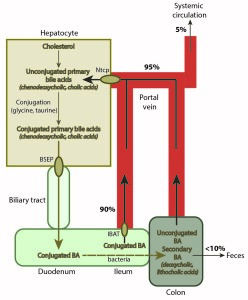Primary bile acids (chenodeoxycholic acid and cholic acid) are produced in the liver from cholesterol. They are conjugated (mostly to glycine and taurine) then excreted into bile via specific transporters (mostly the bile salt export pump, BSEP). Once in the intestine, conjugated bile salts form micelles and emulsify fats, which is required for fat absorption. They are then reabsorbed in the ileum via an active pump, the intestinal bile acid transporter (IBAT). This is 90% efficient. The remaining bile acids are deconjugated or dehydroxylated (forming the secondary bile acids, deoxycholic acid, lithocholic acid), which are then passively absorbed, largely in the colon. The portal blood supply, which drains the intestinal tract, takes conjugated and unconjugated bile acids to the liver, where they are efficiently (95%) extracted by hepatocyte transporters (the sodium taurocholate cotransporter, Ntcp, primarily), such that only 5% of absorbed bile acids enter the systemic circulation (for us to measure). The secondary bile acids that are not reabsorbed are lost in the feces (<10%).

